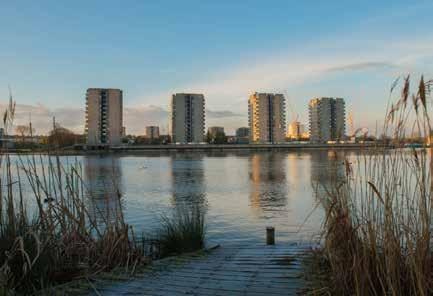
5 minute read
Combating climate change in Thamesmead
Thamesmead in South London is looking at how a landscape-led approach can tackle climate change
When the Greater London Council (GLC) decided in the 1960s to reclaim over a thousand acres of marshes in the eastern reaches of the River Thames, it had a utopian plan for its very own New Town. Channelling the spirit of early pioneers, the opportunity was seized to create an entirely different way of living, nine miles from central London.
Innovative concrete design and modern amenities were to be closely integrated with nature and green space. The marshes were channelled to establish a series of large lakes and a network of canals. A 1970 promotional film described ‘environmental conditions unmatched by anything that has existed before’. The idea was to punt to the shops. Early residents still love the place for giving them what they describe as the best childhood ever, roaming free.

Views across Thamesmead
© Paul Upward
Affordable, healthy and bright homes were the aim of the GLC. Flood risk required habitable rooms to start at first floor level, so the housing was elevated on concrete platforms. The large-scale forms were designed to hold their own in a monumental landscape, with four avant-garde, now iconic towers flanking one lakeside.
Fast-forward 50 years and Thamesmead remains rich in natural resources but they require significant investment to realise their full potential. Our residents have told us that better outcomes for them would mean a safer environment for their children and improved access to a range of opportunities.
Our approach in this area is to work in partnership with residents to respond to the challenges: with a focus on pathways to better economic opportunities and codesigning green spaces. Whilst the population demographic has changed significantly over the years, a strong sense of civic pride remains. With Peabody taking ownership five years ago, Thamesmead’s future is once again in the hands of a single organisation. We’re responsible for 200 acres of developable land and large 1980s estates to be retrofitted for climate resilience.
We’ve inherited a mixed legacy with Thamesmead. The glory of the town lies in its natural assets, its expansive river frontage, woods, water bodies, wetlands and Grade 1 heritage. Back in the 1960s, however, ‘connectivity’ meant building highways which sever the town and segregating motorists from pedestrians who were confined to ‘streets in the sky’. While the town has some fine examples of modernist aesthetic, some of these walkways are characterised by unloved underpasses and garages create long blank frontages to the street. The green open spaces feel curiously empty, because most people drive and few yet walk or cycle.

Views across Thamesmead
© Paul Upward
Regeneration in Thamesmead aims to enable everyone, especially the most vulnerable people, to make the most of their lives. By 2050 the population will have more than doubled to 100,000 and the town must become a place where people are able to live far more sustainably than most of us do today. People will need greater protection from the impacts of the climate crisis, such as the urban heat island effect and torrential summer storms. Success also depends on an abundance of varied places where the established and evolving communities can come together.
Thamesmead presents the biggest and most extraordinary opportunity in London. We believe that the landscape is critical to its future. In fact, the potential of the place will only ever be realised through a landscape-led approach.
So, rather than come up with another top-down masterplan for the town, we’ve commissioned LDA Design to lead a specialist team to develop a green infrastructure and placemaking strategy, to create a holistic approach. The climate crisis is one of the key drivers behind the Strategy. Sea levels are rising in the Thames Estuary: the town will need higher flood defences. But the special opportunity here is for people to become climate aware activists through reconnecting with the extraordinary natural environment on their doorstep.

Views across Thamesmead
© Paul Upward
For this to happen, we need to provide a far richer offer with our public green spaces and make them a safe and inviting place, with an unrivalled range of activities. Like all positive responses to the climate crisis, this brings multiple benefits. Thamesmead will become a much healthier place to live when there is a stronger incentive to get out and get active and meet up with others, especially at a time when loneliness is as grave a threat to health as smoking.
LDA Design is mining a broad range of expertise, from hydrologists to economists, to ensure that the Strategy (to be published in 2020), makes the most of Thamesmead’s natural assets and ensures the town can adapt to global warming. It is exploring how to improve water quality in the lakes, how to fulfil the original vision for the canal network and how to encourage cycling and walking.
We want the streets of Thamesmead to be overpoweringly green, from roof to micro-allotments outside front doors and water in the lakes to be supremely clean. Rainfall should be managed in a visible, playful way that reconnects people to the water cycle. Food growing could be ubiquitous. From parks to tumps, the cultural and play offer needs to delight. We want a well-managed but shaggy network of habitats which strengthen biodiversity. Green infrastructure will be at the heart of emerging technologies for energy and water, minimising investment in traditional ‘grey’ infrastructure that is not future-proofed.
Thamesmead was originally designed as a flagship pioneer, and that is an ambition worth pursuing still. The Strategy will shape placemaking, giving developers a practical guide to creating somewhere that works for everyone, providing for the right sort of growth in the right place and setting the framework for creating value. The future will rest on ongoing investment and strong maintenance strategies.

Views across Thamesmead
© Paul Upward
I think there is much to learn from the history of Thamesmead. In the 1960s, the vision for the place was imposed on it, with residents treated as a homogenous whole rather than individuals with distinct needs and aspirations who could make the neighbourhood their own. In the 1980s and 1990s, when that coherent had vision dissolved, along with stringent design standards, the town attracted opportunistic development.
To respond convincingly to the climate crisis, we need the highest quality sustainable design and standards for buildings and spaces. But Thamesmead must also become a place where its communities choose to be strong advocates for change, and shape the solutions.
Dr Phil Askew is Director of Landscape & Placemaking at Peabody.








